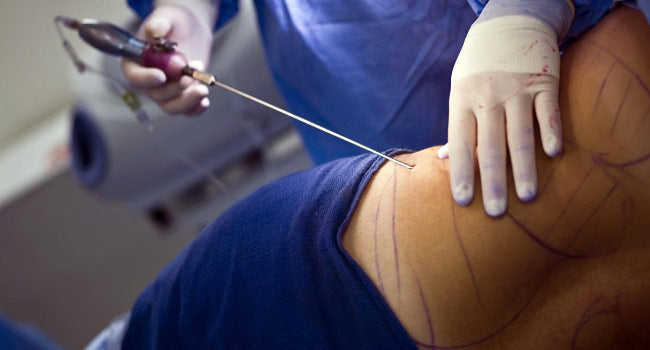How To Use Ultrasonic Cavitation?
Jan 10, 2022
Content
- Principle
- Types
- Notes
Ultrasonic cavitation is known as a new non-surgical fat reduction treatment. With its help, you can lose weight and tighten the skin in problem areas of the body without injecting drugs or exerting physical effort. Visible changes can usually be seen after the first treatment, and the results of a full course of treatment are similar to a month of training at the gym.
 However, in order to maintain the results of the cavitation treatment, it is necessary to change your diet. If you overeat or eat unhealthy after treatment, the broken down fat will build up again.
However, in order to maintain the results of the cavitation treatment, it is necessary to change your diet. If you overeat or eat unhealthy after treatment, the broken down fat will build up again.
Working Principle
Ultrasonic cavitation is a non-injection cosmetic treatment used to remove unwanted fat deposits from problem areas.
Working principle of ultrasonic cavitation:
- Low-frequency ultrasonic waves from a professional ultrasonic cavitation machine.
- Ultrasonic waves form small bubbles inside the fat cells, which gradually increase in size.
- Progressive expansion of fat cells leading to rupture and disintegration of cell membranes.
- Fat cells are destroyed and the intracellular structures are broken down into decay products (triglycerides) that enter the lymphatic vessels and blood vessels, then enter the liver and are broken down into glucose for the body's energy needs.
 Low-frequency ultrasound waves have a destructive effect only on fat cells and therefore do not damage the tissues and organs surrounding the cells, etc.; due to the strength and elasticity of these structures, they do not affect other cells (skin, muscles, and blood vessels) so significantly.
Low-frequency ultrasound waves have a destructive effect only on fat cells and therefore do not damage the tissues and organs surrounding the cells, etc.; due to the strength and elasticity of these structures, they do not affect other cells (skin, muscles, and blood vessels) so significantly.
Types of Ultrasonic Cavitation
-
Ultrasonic cavitation and liposuction
Traditional liposuction is a surgical procedure used to remove excess fat. It is invasive, risky, and requires a pre-surgical preparation period and a post-surgical recovery period.
Laser liposuction is a minimally invasive treatment to remove excess fat deposits. First, laser radiation is used to destroy the fat cells, and then the fat is pumped out through a fine cannula. The disadvantages of this method are the same as those of traditional methods: it is an invasive and invasive method that requires anesthesia, surgical preparation, and a recovery period.

Uses ultrasonic cavitation, eliminating the need for punctures and scalpel cuts. Keeps the skin intact. Under the action of ultrasound, the ruptured fat cells are broken down into fatty acids, which are transported through the lymph and bloodstream to the liver, where they are converted into the energy needed by the body.
Ultrasonic cavitation treatment is painless and requires no hospitalization, no preparation before the procedure, and likewise no recovery period afterward. And in terms of efficiency, ultrasonic cavitation is not inferior to the above two methods in terms of approximately 10-15 kg of slight overweight.
If the patient has severe obesity, a more thorough method of fat tissue removal is required.
-
Vacuum ultrasonic cavitation
Vacuum ultrasonic cavitation treatment is performed using specialized equipment that combines the effects of ultrasound and vacuum. As the ultrasound breaks down and destroys the fat cells, the fatty acids are removed from the body faster with the help of the vacuum action, and the combination of the two improves the overall effect of fat reduction.
No additional lymphatic drainage is required after vacuum ultrasonic cavitation, as it is performed simultaneously with the treatment. The result of vacuum massage is stimulation of tissue metabolism and tightening and lifting of the skin. Usually, after the first treatment, the treated area is reduced by 2 cm and the effect of this combination treatment is obvious. After a few days, the effect will get better and better.

Comparing the results at the end of the entire session, we found that the effect of vacuum ultrasonic cavitation removes more fat in a single session at most than classical ultrasonic cavitation. In addition, the combination of vacuum and ultrasonic cavitation is faster - only 30 minutes compared to 60-90 minutes for classical ultrasonic cavitation and lymphatic drainage, but they are equally efficient.
-
Ultrasonic cavitation and RF lifting
RF lifting is a non-invasive skin tightening treatment that operates using high-frequency electrical currents. It penetrates deeply and heats the deeper layers of the dermis, improving blood microcirculation and tissue oxygen saturation, accelerating metabolic processes in cells, and activating collagen and elastin synthesis. The result of cavitation RF is smoother and firmer skin and a possible improvement in the complexion of problem areas.
The primary role of ultrasonic cavitation is to burn fat deposits. The combination of ultrasonic cavitation and RF lifting achieves the maximum effect of this process. Subcutaneous fat cells are broken down and, due to the heating, the process of elimination of the destroyed cells from the body is accelerated. Improved microcirculation prevents skin edema.

In addition, the skin tightens faster when a void is formed under the skin, so even if the fat is reduced, it does not cause the skin to sag. The two treatments, ultrasonic cavitation, and RF lifting complement each other. Therefore, aestheticians recommend combining them to achieve better fat reduction results.
Notes on Ultrasonic Cavitation Treatment
- Before starting the treatment, the aesthetician must collect and understand the patient's case well. Although ultrasonic cavitation is effective, it still has many contraindications to the cavitation treatment. Since a large amount of fat cell breakdown products are formed during the cavitation treatment, this may negatively affect the health of patients suffering from certain types of diseases.
- Identify and mark the patient's problem areas to be treated before treatment.
- After identifying the area to be treated, a special ultrasonic gel is applied to the skin and then the problem area is massaged in a circular motion using the cavitation handle on a professional ultrasonic cavitation machine. Patients may experience mild skin irritation or redness, which usually disappears within a few days.
- As the cavitation treatment progresses, the focus is placed on the areas of the skin that need the fattest elimination. Each area takes approximately 15-20 minutes.

- The duration of cavitation treatment depends on the patient's physical condition and the size of the area to be treated, usually 4-15 sessions, with a recommended interval of about one week between each treatment.
- Before and after cavitation treatment, patients must drink at least 1.5-2 liters of purified water. This will improve the efficiency of cavitation treatment and accelerate the elimination of fat cells decay products from the body while reducing the burden on the liver and the side effects of cavitation treatment.
- After each cavitation treatment, it is recommended to combine with lymphatic drainage massage. This will increase the effectiveness of the cavitation treatment and accelerate the rapid elimination of the destroyed fat cells from the body.
- Patients must have a strictly controlled diet. It is necessary to exclude foods that affect the liver such as fried, spicy, high salt, alcohol, and carbonated beverages. After cavitation treatment, uncontrolled eating habits can still lead to fat accumulation.

